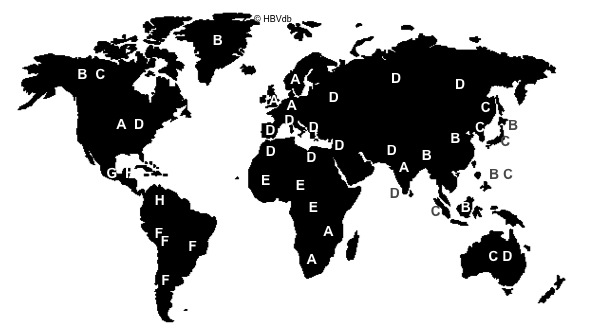
Nomenclature
Genotypes
There are eight genotypes [1,2] of HBV designated A to H based on greater than 8% nucleotide variation over the entire genome. Hepadnaviruses infecting primates like the chimpanzee, orangutan and gibbon are very similar and can be regarded as genotypes of HBV [3,4].
The eight genotypes of HBV show a distinct geographical distribution and influence the course of disease and the prognosis of treatment.
Reference Genomes
HBVdb is built thanks to a fully automated annotation procedure applied to the HBV sequences from the European Nucleotide Archive (ENA). The automatic annotation process uses a reference set of complete genomes representing the 8 genotypes.
CDS and protein names
The list of CDS and protein names used in HBVdb is indicated in the following table.
| CDS* | | Proteins | | Usual names |
|---|---|---|
| PreC | HBe | Precore | HBe antigen | PreC |
| C | HBc | Core | Capsid | HBc antigen | C |
| X | HBx | X protein | HBx | X |
| PreS1 | LHBs | Long surface protein | PreS1 |
| PreS2 | MHBs | Middle surface protein | PreS2 |
| S | SHBs | Small surface protein | S | HBs antigen |
| P | Pol | Polymerase | Reverse Transcriptase |
| SP | HBSP | Hepatitis B Spliced Protein | HBSP |
*CDS: nucleotide coding sequence
Numbering
The usual numbering of a complete genome in HBVdb uses the EcoR1 restriction site as the +1. The master reference entry of HBVdb is the X02763 entry (genotype A). In the ENA, its sequence is not in the usual numbering. In HBVdb, X02763 was renumbered using the usual numbering.
Bibliographic References
Hepatitis B virus genotypes: comparison of genotyping methods.
Bartholomeusz A., Schaefer S.
Rev Med Virol, 2004, 14(1):3-16.Hepatitis B virus taxonomy and hepatitis B virus genotypes.
Schaefer S.
World J Gastroenterol, 2007, 13(1):14-21.Hepatitis B virus genetic variability and evolution.
Kay A., Zoulim F.
Virus Res, 2007, 127(2):164-176.Hepatitis B virus infection from an evolutionary point of view: How viral, host, and environmental factors shape genotypes and subgenotypes.
Araujo N.M., Waizbort R., Kay A.
Infect Genet Evol, 2011, 11(6):1199-1207.
